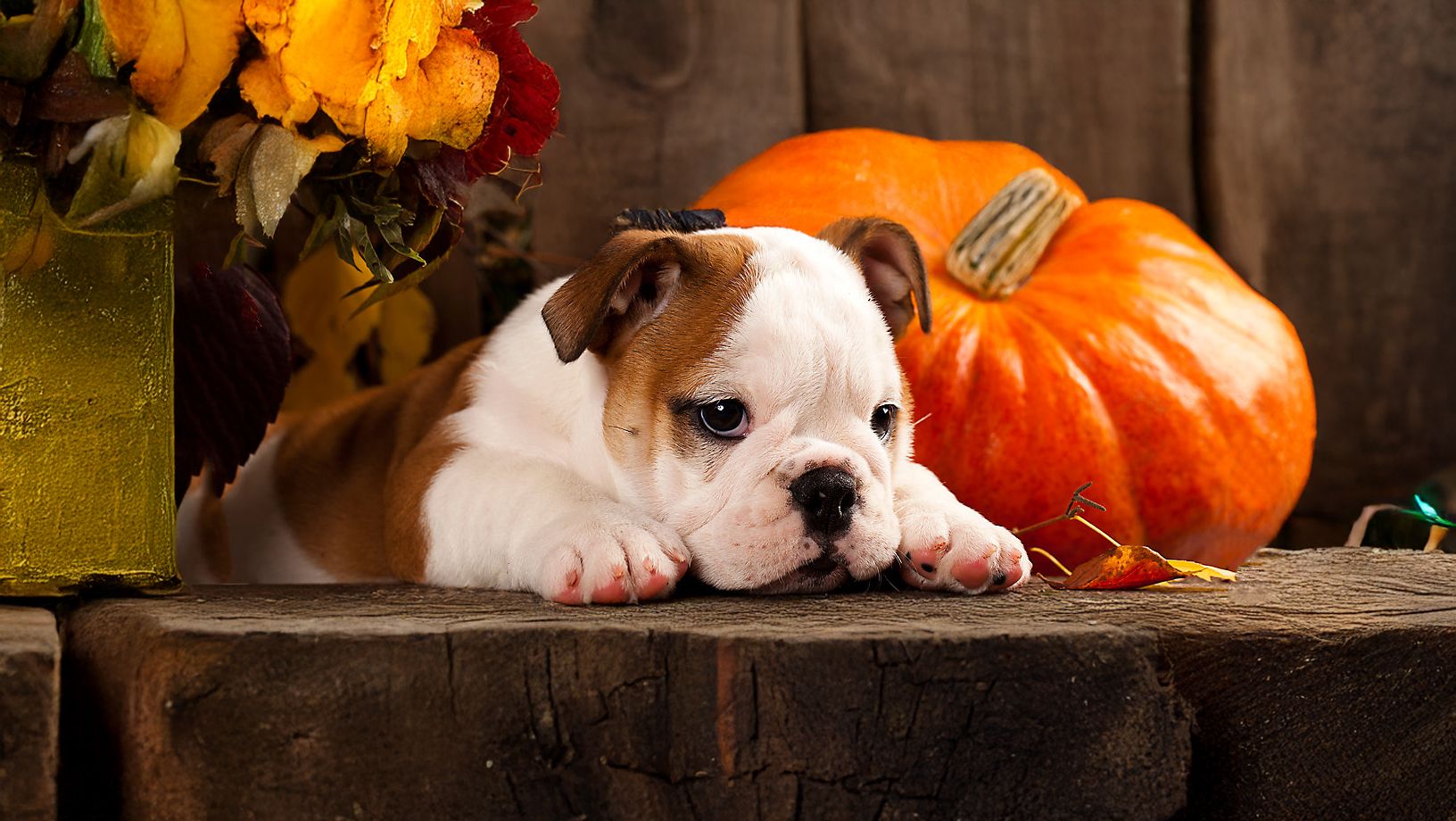Halloween Dog Training Tips: How to Prep for Trick-or-Treaters

In this Article
- Trick 1: Teach your dog to “sit”
- Trick 2: Teach your dog to “wait”
- Trick 3: Teach your dog to “leave it”
- Train for Halloween-specific distractions
- Common Halloween training mistakes (and how to fix them)
- Not every dog is a Halloween dog (and that’s okay)
- FAQs
- Why choose PetSmart for training support?
Halloween can be exciting for kids but overstimulating for your dog. New people, scary costumes, unfamiliar smells—it can all be a lot to handle for our four-legged friends. If your pup barks at the doorbell, jumps on guests, or tries to sneak candy off the floor, you're not alone.
With the right training or management plan, you can help your dog stay calm, polite, and safe when the big night arrives.
Trick 1: Teach your dog to “sit”
Why it helps: “Sit” keeps your dog calm and grounded when trick-or-treaters arrive.
How to teach it:
- Hold a dog training treat right at your dog’s nose
- Move the treat slowly upward, just over their head
- As they follow the treat, they’ll naturally lower into a sitting position
- Once they sit, praise them and give the treat
- Repeat this while adding the word “Sit” at the beginning
Training tip: Practice for 5–10 minutes a day. Most dogs learn this cue in under a week.
Trick 2: Teach your dog to “wait”
Why it helps: Helps stop your dog from running to the door when it opens.
How to teach it:
- Ask your dog to sit
- Say “Wait” while holding out your hand like a stop sign
- If they pause, even briefly, reward them
- Gradually increase the time they stay still
- Add distractions like knocking, the doorbell, or a friend in costume
Training tip: Practice near the door so your dog learns to wait even with spooky sounds or costumes nearby.
Trick 3: Teach your dog to “leave it”
Why it helps: Keeps your dog away from dropped candy, décor, or anything unsafe. How to teach it:
- Place a plain treat on the ground
- Cover it with your hand and wait
- As soon as your dog stops reaching for it, praise and reward them with a tastier treat
- Repeat while saying “Leave it” each time
- Progress to uncovered treats or real-life distractions
Safety tip: Many Halloween treats (like chocolate or xylitol-sweetened candy) are toxic to dogs. Teaching “leave it” helps protect them. You can still offer your dog appropriate Halloween dog treats.
Train for Halloween-specific distractions
Don’t just train in a quiet room, practice with the sights and sounds of Halloween:
- The doorbell ringing repeatedly
- Shouting or running kids
- People in masks or costumes
- New smells, decorations, or flashing lights
- You dressed differently or holding props
Tip: Start low and build up. If your dog isn’t able to follow commands consistently, they may be over the threshold of stimulus they can tolerate. Remember, your dog sets the pace of how quickly they progress with commands. Use praise and rewards to help your dog feel confident around each new element.
Common Halloween training mistakes (and how to fix them)
Even experienced pet parents can overlook these:
- Starting too late: Begin training at least 2–3 weeks ahead of Halloween to give your dog time to build habits. It takes time and many repetitions for commands to become reliable, especially in distracting or stressful situations.
- Only practicing in quiet spaces: Train near the front door and slowly add realistic distractions
- Over-relying on treats: Once your dog understands the command, start mixing in verbal praise or play with their favorite Halloween toy
- Letting dogs roam near the door: Even well-trained dogs can bolt in the chaos. Use a Halloween dog leash, gate, or keep them behind a door during busy hours
Not every dog is a Halloween dog (and that’s okay)
Even with great training, Halloween might still feel overwhelming for your pup, and that’s not a failure. Some dogs struggle with unpredictable sights and sounds no matter how much prep you do.
If your dog gets anxious or reactive despite training:
- Set them up in a crate or quiet room away from the door
- Use calming aids or interactive toys to help them relax
- Skip the training and focus on comfort and safety
You know your dog best. Sometimes the kindest thing you can do is give them space and skip the festivities altogether.
FAQs
How early should I start training for Halloween?
Start at least two to three weeks in advance to build consistent behavior through repetition and rewards.
Start at least two to three weeks in advance to build consistent behavior through repetition and rewards.
What if my dog is afraid of costumes or decorations?
Desensitize them gradually. Let them sniff costumes or decorations during quiet times, rewarding them with treats for calm behavior. Management is key. If the unpredictable nature of Halloween trick-or-treating is too much for your dog to handle, it may be best to keep them away from the door.
Desensitize them gradually. Let them sniff costumes or decorations during quiet times, rewarding them with treats for calm behavior. Management is key. If the unpredictable nature of Halloween trick-or-treating is too much for your dog to handle, it may be best to keep them away from the door.
Can treats be used too much during training?
Not if you keep treats small and healthy. Training treats should be low-calorie and used as motivation, not a meal replacement.
Not if you keep treats small and healthy. Training treats should be low-calorie and used as motivation, not a meal replacement.
Is crate training a good option on Halloween night?
Yes, if your dog finds their crate comforting. A crate in a quiet room can be a safe space away from the noise and foot traffic.
Yes, if your dog finds their crate comforting. A crate in a quiet room can be a safe space away from the noise and foot traffic.
Why choose PetSmart for training support?
PetSmart offers more than just supplies, we offer support. Whether you’re prepping for Halloween or working on everyday manners, PetSmart Accredited Trainers can help your dog learn key commands in a fun, positive environment.
- Accredited in-house dog trainers
- Group and private sessions available
- Puppy, beginner and advanced levels offered
- Positive reinforcement methods
Visit the PetSmart Dog Training page to explore classes near you or book online today.
In this Article
- Trick 1: Teach your dog to “sit”
- Trick 2: Teach your dog to “wait”
- Trick 3: Teach your dog to “leave it”
- Train for Halloween-specific distractions
- Common Halloween training mistakes (and how to fix them)
- Not every dog is a Halloween dog (and that’s okay)
- FAQs
- Why choose PetSmart for training support?


